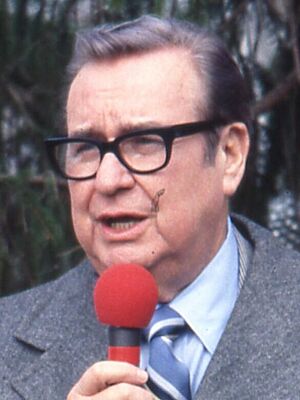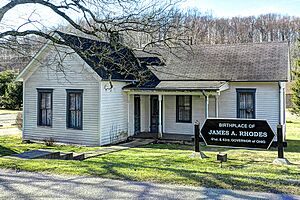Jim Rhodes facts for kids
Quick facts for kids
Jim Rhodes
|
|
|---|---|

Rhodes in 1981
|
|
| 61st and 63rd Governor of Ohio | |
| In office January 13, 1975 – January 10, 1983 |
|
| Lieutenant | Dick Celeste (1975–1979) George Voinovich (1979) Vacant (1979–1983) |
| Preceded by | John J. Gilligan |
| Succeeded by | Dick Celeste |
| In office January 14, 1963 – January 11, 1971 |
|
| Lieutenant | John W. Brown |
| Preceded by | Michael DiSalle |
| Succeeded by | John J. Gilligan |
| 21st Ohio State Auditor | |
| In office 1953–1963 |
|
| Governor | Frank J. Lausche John William Brown C. William O'Neill Michael DiSalle |
| Preceded by | Joseph T. Ferguson |
| Succeeded by | Roger W. Tracy Jr. |
| 44th Mayor of Columbus | |
| In office 1944–1952 |
|
| Preceded by | Floyd F. Green |
| Succeeded by | Robert T. Oestreicher |
| Personal details | |
| Born |
James Allen Rhodes
September 13, 1909 Coalton, Ohio, U.S. |
| Died | March 4, 2001 (aged 91) Columbus, Ohio, U.S. |
| Resting place | Green Lawn Cemetery Columbus, Ohio |
| Political party | Republican |
| Spouse |
Helen Rawlins
(m. 1941; died 1987) |
| Children | 3 |
| Education | Springfield High School |
| Alma mater | Ohio State University |
James Allen Rhodes (born September 13, 1909 – died March 4, 2001) was an American politician. He was a member of the Republican Party. Rhodes served as the Governor of Ohio for four terms. This made him one of only seven U.S. governors to serve four four-year terms. He also held important roles like Mayor of Columbus and Ohio State Auditor.
On May 3, 1970, Governor Rhodes sent National Guard troops to Kent State University. This happened after a building on campus was burned down. The next day, May 4, Guardsmen shot and killed four students. Nine others were wounded.
Contents
Early Life and Education
Rhodes was born in Coalton, Ohio. His parents, James and Susan Howe Rhodes, were of Welsh background. When he was nine, his father passed away. His family then moved to Springfield. Rhodes graduated from Springfield High School, where he played football.
Later, his family moved to Columbus. Rhodes received a small basketball scholarship to Ohio State University. However, he left college after his first quarter. Even so, he was often called a "student" or "alumnus" of Ohio State.
After leaving college, Rhodes started a business. It was called Jim's Place and was located near the university.
Political Career
Mayor of Columbus (1944–1952)
Rhodes began his political journey in Columbus in 1934. He started on a local ward committee. In 1937, he won his first elected job on the Columbus Board of Education. He was then elected Columbus city auditor twice, in 1939 and 1941.
In 1943, Rhodes became the Mayor of Columbus. He was only 34, making him the youngest mayor of a major U.S. city at that time. As mayor, Rhodes had two main successes. First, he convinced most Columbus voters to approve the city's first income tax.
Second, he used a clever strategy to add many nearby areas to Columbus. These growing communities needed access to water. The city's municipal water system controlled the waterlines. Rhodes told these communities they could get water only if they joined Columbus. Because of this, Columbus now has the largest land area of any city in Ohio.
Governor of Ohio
To prepare for running for governor, Rhodes was elected State Auditor in 1952. He took office in early 1953. In 1954, he ran for governor but lost to the popular Democratic governor, Frank Lausche.
In 1962, Rhodes ran for governor again. This time, he was against the current Democratic governor, Mike DiSalle. Rhodes's campaign focused on "jobs and progress." He often said that more jobs would reduce crime and other problems. He also highlighted DiSalle's tax increases, like the gas tax. On November 6, 1962, Ohio voters elected Rhodes as governor. He won with 59% of the votes.

Rhodes served two terms as governor. He was also a "favorite son" candidate for president in 1964 and 1968. This meant he controlled Ohio's votes at the Republican National Conventions. He left office in 1971. In 1970, he ran for the U.S. Senate but lost in the primary election.
During his time as governor, Rhodes supported a county airport program. After voters approved it in 1965, 50 airports were built across Ohio.
The Ohio Constitution limits governors to two four-year terms in a row. So, when Rhodes tried to run again in 1974, his request was initially denied. However, the Ohio Supreme Court decided that the limit was only on consecutive terms. This allowed him to run again. He narrowly won against the current governor, John Gilligan, in an unexpected victory.
He served two more terms, retiring again in 1983. During a severe energy crisis in the winter of 1976–77, Rhodes led a short prayer service. He asked God to help end the storm. The next year, January 1978, a huge blizzard hit Ohio. It dropped 31 inches of snow and caused many problems. Rhodes called it "the greatest disaster in Ohio history."
In 1979, the United States and China started having normal relations. Rhodes wanted to build economic ties with China. He saw China as a possible market for Ohio-made machines. In July 1979, Rhodes led an Ohio Trade Mission to China. He met with Chinese leaders, including Vice Premier Yu Qiuli. This trip helped create economic connections. It also led to a sister state relationship with Hubei province. There were also Chinese exhibitions at the Ohio State Fair and exchanges between Ohio State University and Wuhan University. Rhodes believed that Chinese investment would help Ohio.
Rhodes ran for governor one last time in 1986. He was 77 years old and hoped for a record-breaking fifth term. However, he lost to the current governor, Dick Celeste.
Literary Works
Rhodes co-wrote historical fiction stories with Dean Jauchius. These included The Trial of Mary Todd Lincoln and The Court-Martial of Oliver Hazard Perry. He also wrote Johnny Shiloh, a novel of the Civil War. This last book was made into a 1963 TV movie by Walt Disney, also called Johnny Shiloh. Rhodes received credit as a writer for the film.
Personal Life
From 1941 until her death in 1987, Rhodes was married to Helen Rawlins. They had three children together.
In 1995, Rhodes had a stroke, which meant he needed to use a wheelchair. He was hospitalized for pneumonia in late 2000 and early 2001. On March 4, 2001, Jim Rhodes died in Columbus from heart problems. He is buried at Green Lawn Cemetery, Columbus, Ohio.
Legacy
Many buildings and places in Ohio are named in honor of Jim Rhodes. These include:
- The James A. Rhodes State Office Tower in Columbus, which is the city's tallest building.
- A statue in front of the office tower.
- Cleveland State University's Rhodes Tower in Cleveland.
- The Ohio State University Medical Center's Rhodes Hall, the main building of University Hospital.
- The James A. Rhodes Arena (nicknamed "The JAR") at the University of Akron.
- James A. Rhodes State College in Lima, Ohio.
- The Rhodes Center at the Ohio Expo Center and State Fair in Columbus.
- The James A. Rhodes Appalachian Highway, Ohio State Route 32.
- The James A. Rhodes Athletic Center at Shawnee State University.
- James A. Rhodes Airport in Jackson, Ohio.
Electoral History Summary
Jim Rhodes ran for Governor of Ohio several times, winning four terms.
1962 Election
Rhodes won his first term as governor, defeating Michael DiSalle.
1966 Election
Rhodes won a second term, defeating Frazier Reams Jr.
1974 Election
Rhodes won his third term, narrowly defeating John J. Gilligan.
1978 Election
Rhodes won his fourth term, defeating Dick Celeste.
1986 Election
Rhodes sought a fifth term but lost to Dick Celeste. This was his last campaign for Governor.


